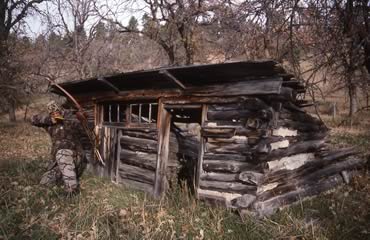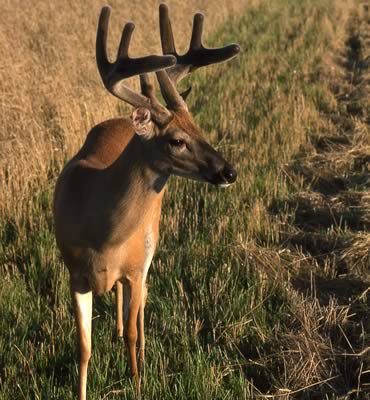Bucks often use man-made structures and cover to hide in plain sight.
It was the day before Halloween, and it was cold, even for Minnesota. With an early morning temperature near zero and a stiff northwest wind, I shivered with more than anticipation as I made my way across the grassy meadow.
Tall grass bordering the fence line I followed shimmered like a million diamonds in the fading moonlight, and somewhere off in the distance a coyote howled, which somehow only made me feel colder. Finally reaching the huge, old basswood that held my portable treestand, I climbed aloft and settled in for the long, frigid day.
As the world around me turned from black to gray, I surveyed my surroundings — a steep, heavily timbered ridge off to the north, an ice-covered slough rimmed with cattails just beyond, and a mix of oaks, basswood and brush surrounded my ambush. There was a clearing directly in front that showed the remnants of overgrown foundations from a long-forgotten farmstead.
Forty or so yards east of my perch was a small grove of apple trees, a few still bearing fruit. Within bow range of my ambush was a gaping hole in the earth which long ago was the home’s root cellar, but now served me well as a funnel that would direct deer closer to my waiting bow.
Deer filtered through the abandoned farm site throughout the day. Many passed within range of my hiding spot, and as the day wore on, a sense of urgency spawned by cold temperatures and spits of snow seemed to overtake the local bucks. They began to trot by with increased regularity as their urge to procreate intensified. Twice over the course of the vigil, I saw a monster 8-pointer, even having the big deer follow a doe at close range without offering a shot. But now the sun was nearly touching the horizon, and I stood with longbow poised as I tried to shake the stiffness from my bones.
The sun kissed treetops to the west, and I was thinking of a warm cup of cocoa when the clear, measured grunts of an amorous buck reached my ears. Down the ridge from the north came a trotting pair of whitetails, a reluctant doe in the lead with a massive 8-point buck in tow. As the doe reached the farmstead, she dodged deftly through the vines, cedars, and crumbling rock foundations, momentarily losing her suitor, which worked perfectly for me. He coasted to a stop below my perch and searched for the object of his desire.
At less than 10 yards, he was well within range, but overhanging branches screened his massive body. Finally taking several quick steps toward the large scrape I was watching, the deer paused again. I leaned forward and bent over until a small opening appeared and framed the trophy’s chest. The heavy wooden arrow gobbled up the yardage in the blink of an eye and buried deeply in the big buck’s ribcage.
 Without question, the white-tailed deer is the world’s number-one game animal. One reason is their beauty and grace. Another is that their numbers are at all-time highs over much of their range. This, in turn, is because the whitetail is so adaptable and thrives in the shadows of man.
Without question, the white-tailed deer is the world’s number-one game animal. One reason is their beauty and grace. Another is that their numbers are at all-time highs over much of their range. This, in turn, is because the whitetail is so adaptable and thrives in the shadows of man.
Rare would be the farmer or rural homeowner who hasn’t surprised deer, including big bucks, right in a front yard. At my country home in Minnesota, we regularly watch deer in the yard. Each fall, I see the local bucks’ destructive nature as they attack the pine trees behind my house. Yes, deer live and thrive in the shadows of our architecture. And for my money, there is no better place to ambush a big whitetail than around old, abandoned farmsteads.
Farmsteads become abandoned as our country becomes more and more urban. While losing this piece of American history makes me sad, it offers a goldmine for hunters. Deer move in and take up residency about the same time the owners pull out of the driveway for the last time. The animals are attracted to these sites for the same reasons the humans were. They almost always offer cover, water, food and protection from the elements.
Take, for example, a remote Minnesota farm site that I often bowhunted when I was younger. At first glance, the small woodlot seemed nondescript. Upon closer inspection, it provided dense cover, food in the form of oaks, apple trees and an overgrown garden, and water from a small lake bordering the northern edge of the lot. When I first began hunting this whitetail paradise, a couple of the buildings were still standing. In severe weather, I was often able to follow tracks in the snow. Sometimes deer were using the buildings for shelter, yet few hunters bothered this site because it was a long hike from the road and didn’t look like much from a distance.
I remember five bucks harassing a giant doe one cold November morning while hunting with my dad. Although this hunt was a couple decades ago, it stands out as one of my most memorable days in the woods, although I never drew my bow.
 Another reason I’ve noticed an old farmstead is so attractive to deer is the openings in the otherwise dense cover provided by the farmyard itself. Even years after the site is abandoned, the yard generally stays fairly open. It is a rarity that these old farmyards don’t show a wealth of rutting activity. The farm mentioned in the opening story is a perfect example.
Another reason I’ve noticed an old farmstead is so attractive to deer is the openings in the otherwise dense cover provided by the farmyard itself. Even years after the site is abandoned, the yard generally stays fairly open. It is a rarity that these old farmyards don’t show a wealth of rutting activity. The farm mentioned in the opening story is a perfect example.
Although the old yard is partially overgrown with tall grass and weeds, it is still much more open than the surrounding woods. The site is absolutely torn up with rubs and scrapes every year. I counted 19 large scrapes along the clearing surrounding the old foundations one fall, and most years each oak branch that overhangs the old farmyard shows a rutting buck’s signature.
My preferred ambush at the second old farm was always a natural stand in a huge, ancient oak that guarded the driveway. Deer used this relatively clear lane to access the area, and the heavy trail that meandered up the old drive was always beat right down to the dirt.
Hunting abandoned farms is usually pretty easy, since most deer activity will be close to the farmstead itself. Slip in from downwind and set up overlooking the opening where the yard used to be. You’re likely to see whitetails at any time throughout the day. Setting up on an active scrape is another good bet, as is the downwind edge of fruit trees or an overgrown garden.
Orchards and gardens are almost always present at old farmsteads, and the majority of deer check these locations for food. These snack sites can be dynamite ambushes early in the season when the mast, fruit and produce are ripening and drawing whitetails from miles around.
One of my favorite techniques when hunting old farmsteads is to set up in the buildings. It’s rare for an abandoned farm not to have a building or two standing. Wildlife has no fear of these structures and will use them for shelter as readily as any natural cover.
There are many benefits to hunting from within an old house or barn. They provide cover in addition to shelter from the elements during long vigils. The semi-enclosed hideouts tend to trap human odor, making it less likely game will smell danger; solid walls prevent game from spotting movement as you prepare for a shot.
On the downside, old buildings can be unsafe, so make sure to check for hazards well before the season and during full daylight. Never slip into an old house or other building in the dark without having thoroughly checked it ahead of time in the daylight.
The only other drawback I’ve experienced while hunting from inside an old building is finding myself sharing the space with other critters. Rats and mice, bats, raccoons and skunks are frequent inhabitants of abandoned farmsteads. I remember one old house that I used in North Dakota was full of raccoons, so every evening before dark, the scratching and growling would start either above me in the attic or below me in the basement. Only once did I actually have one of the inquisitive furbearers slip into the upstairs bedroom to check on me. The result of that hunt was a big boar’s tanned hide that now graces the wall of my bow shop.
Of course, even though a farm might be abandoned, you must still obtain permission to hunt the property. I always let a landowner know if I think it likely that I will actually use the buildings for cover.
It is possible to find abandoned farmsteads on public land as well. In my opening story, I was bowhunting a large waterfowl production area when I arrowed the big buck near an old stone foundation.
Taking up the trail of the trophy whitetail, it was difficult to find much blood sign, which wasn’t surprising. The arrow, penetrating down and forward through the ribs, had squarely hit the off-shoulder. After its initial frantic burst, the deer turned onto a main trail through the thicket, then up the ridge. I found what turned out to be my heaviest buck ever piled up in the tall grass along the edge of the slough some 175 yards away.
Field-dressing at more than 230 pounds, the mid-130-class 8-pointer would have had a live weight pushing 300 pounds — that’s a big deer anywhere. That such a trophy was using an abandoned farmstead as his living quarters is no surprise, though. Do yourself a favor and take a hard look at these areas while scouting to try to find some architectural whitetails of your own.
This article was published in the October 2007 edition of Buckmasters Whitetail Magazine. Join today to have Buckmasters delivered to your home.